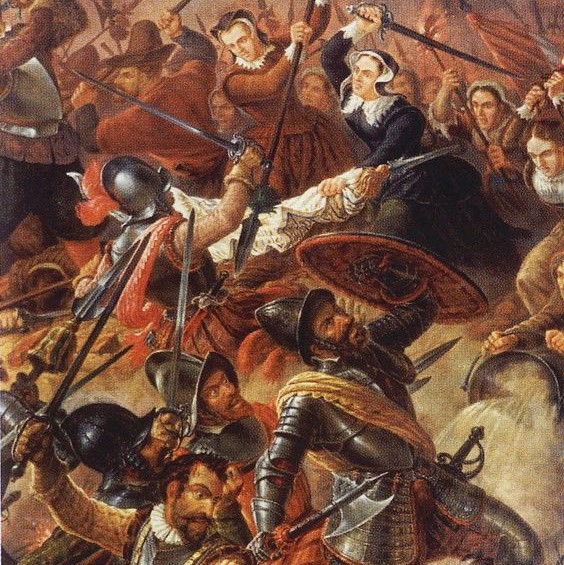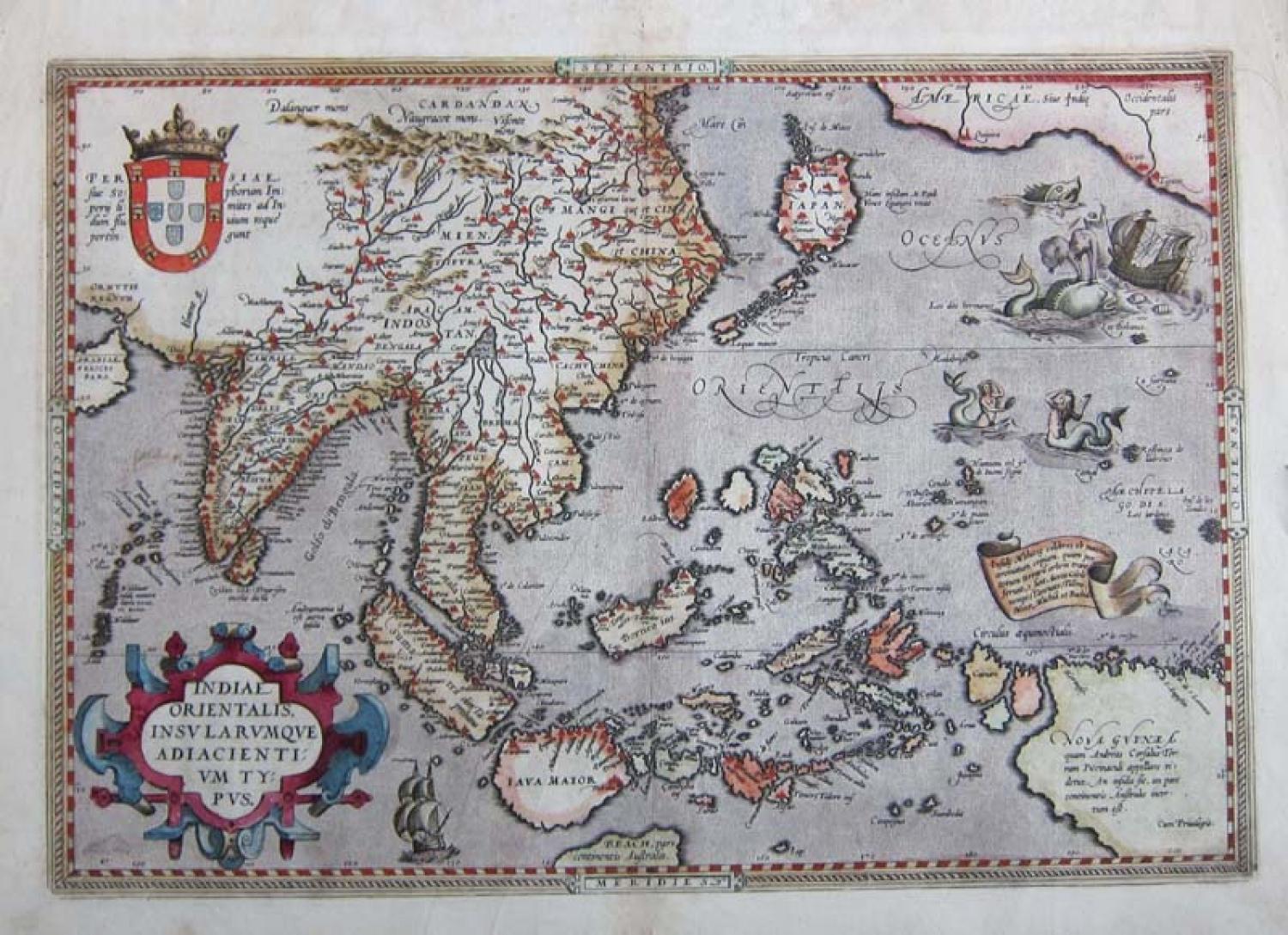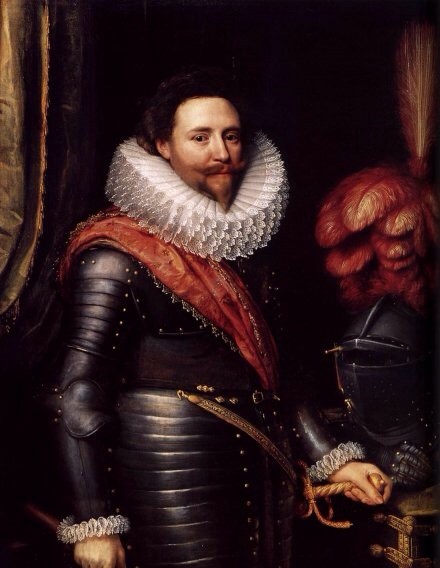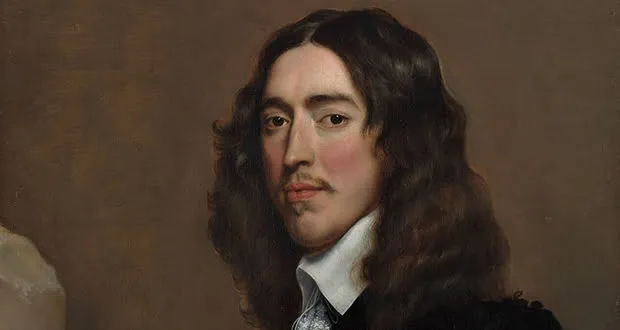The Dutch Golden Age
1588 – 1702
The purpose of this site
First of all, welcome to my site. It is a pleasure take you on a journey back in time to the Dutch golden age. A period in the history of the Netherlands, roughly spanning the era from 1588 (the birth of the Dutch Republic of the United Seven Provinces) to the death of Stadholder Willem III in 1702, in which Dutch trade, science and art and the Dutch military were among the most acclaimed in Europe.
But why this site? First of all, I am writing a series of books spanning the whole of the Golden age and I am using this site to organise the numerous events that took place in this period. Events not only in The Dutch Republic and the Spanish Netherlands (current Belgium and Luxembourg), but on every continent where Dutch ruled or had trade posts. The continents spanned from Nova Zembla and Spitsbergen in Europe’s current Russia and Norway, New Netherlands (with New Amsterdam, now New York) and New Holland (Acadia) in North America, tot Dutch Brazil, The Guianas (Suriname) in South-America and the Dutch Antilles and the Virgin Islands in the Caribbean. Furthermore, a lot of events took place on the Ivory and Gold Coast, the Dutch Cape Colony and Mauritius in Africa. The Dutch ruled over many Asian colonies, such as Dutch India and Bengal, Dutch Ceylon, Dutch East Indie (now Indonesia), Dutch Malacca and Dutch Formosa (Taiwan) with a string of trading posts from Tonkin (Vietnam), China, Siam (Thailand), Japan to many countries in the Middle-East.
Secondly, most Dutch history is written in Dutch. With this site I aim to make Dutch history more accessible to non-Dutch speakers all over the world and especially for those in the many countries we touched over time. Those people with ancestors with whom we traded, loved, mingled or fought, those attracted by the the magic of art or the science of that period, or those who are related to the slave trade, the most terrible part of the world’s and, unfortunately, also our history.
I hope you will enjoy the journey.
Ronald Teuthof
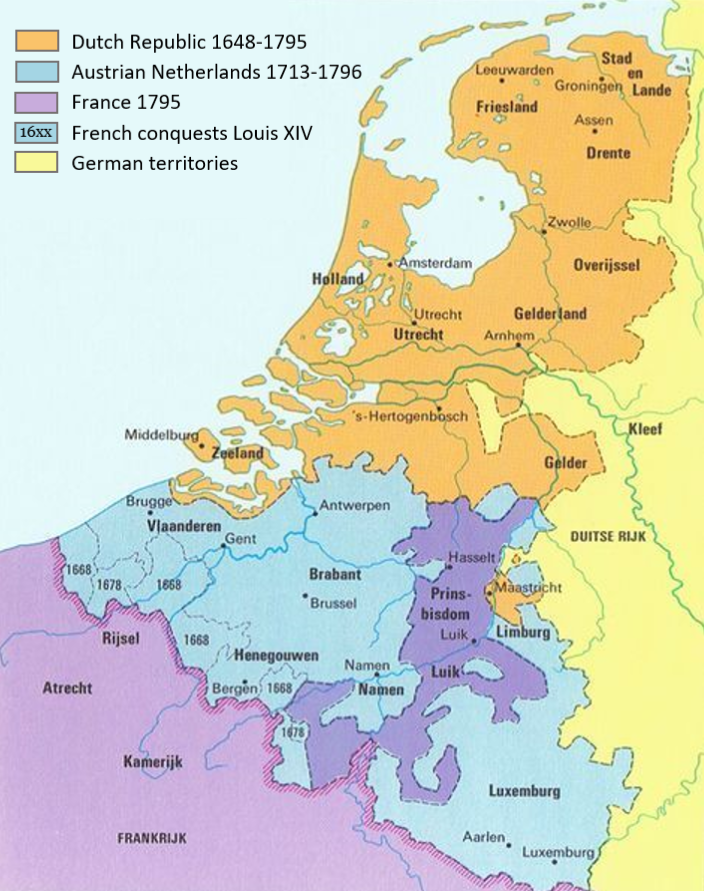
The Dutch golden age covers the period from the proclamation of the Republic in 1588 until 1702, the year that Stadtholder William III dies. During the golden age the world changed dramatically. In 1588 the world was ruled by Spain and Portugal and in 1702, the Dutch had conquered large part of the Portuguese colonies and again lost major areas to the then upcoming countries England and France who until the 20’th century would dominate the globe. Only some islands in the Caribbean are still Dutch after they granted independence to Indonesia and Suriname in 1950 and 1975.
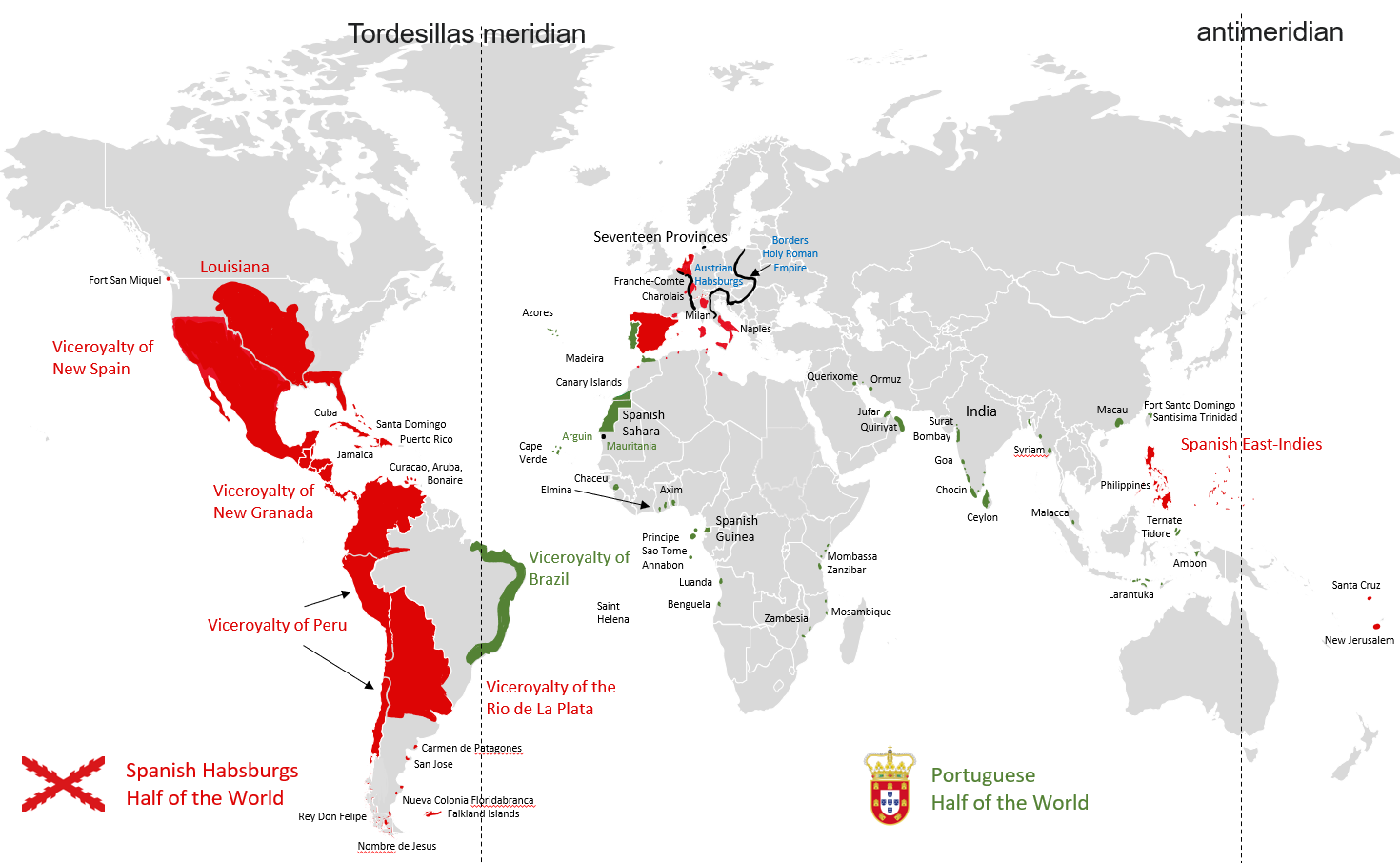
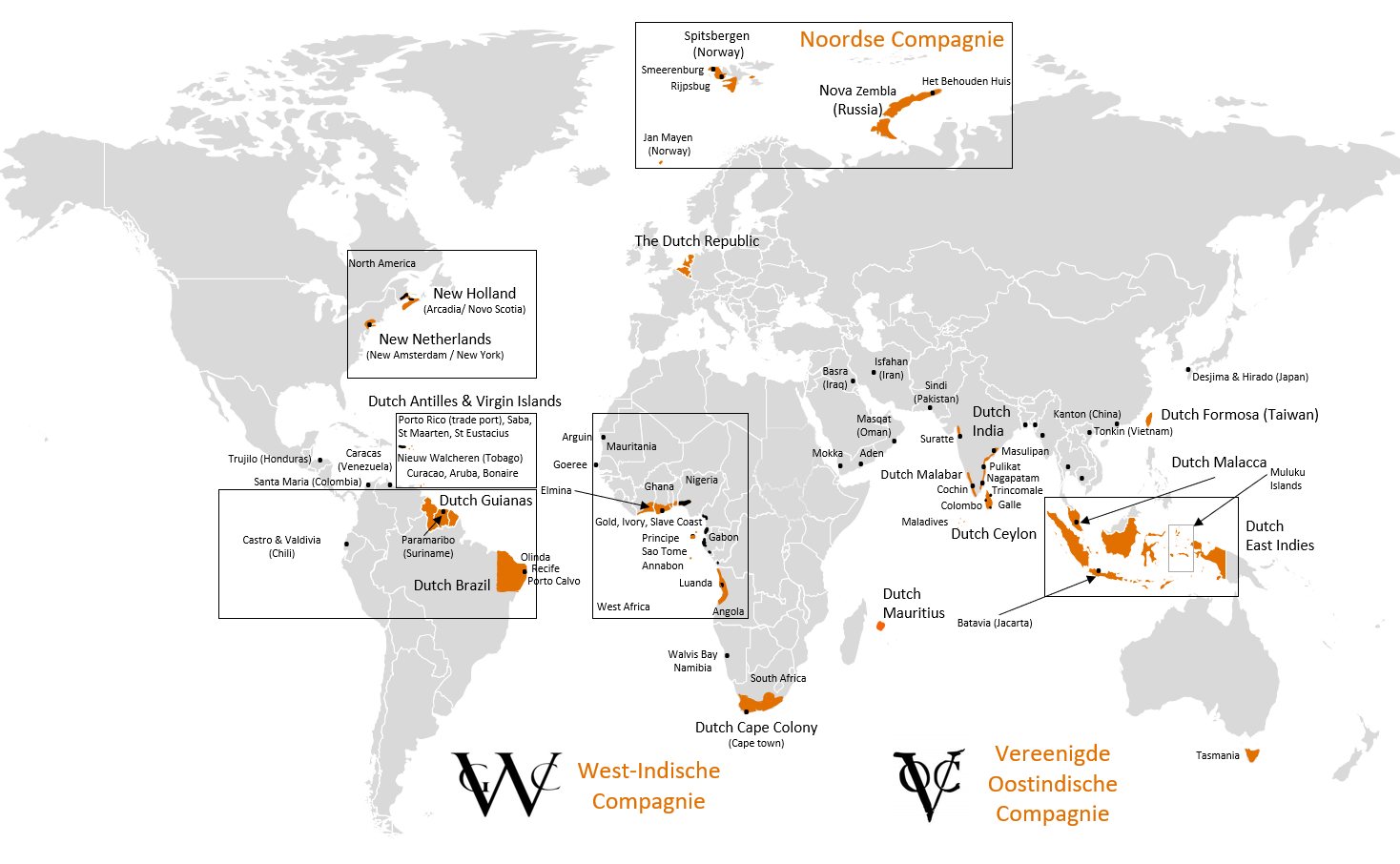
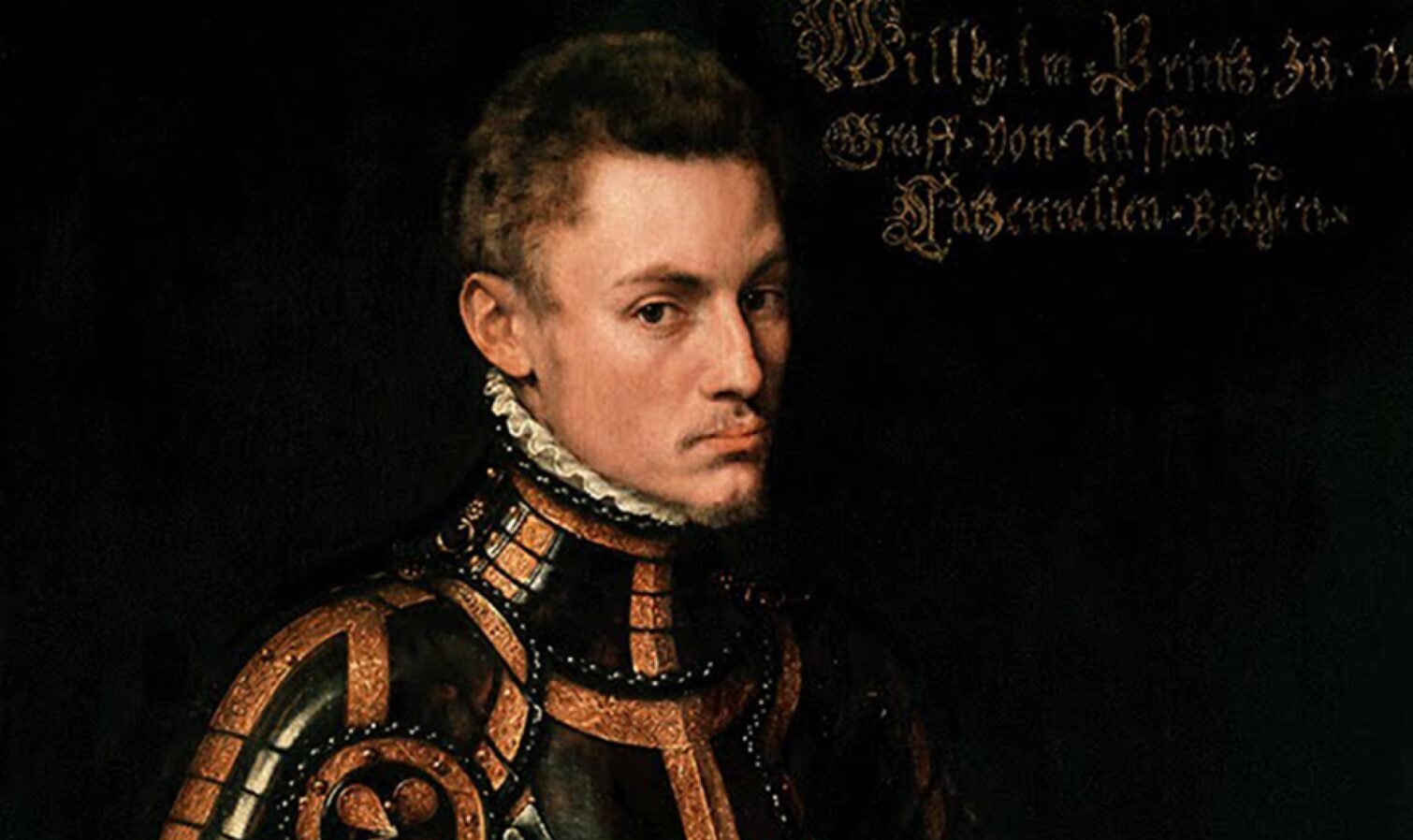
The world in 1588 belongs to Spain and Portugal
Before 1588, the Netherlands as Seventeen Provinces were part of the empire of Philip II, who was also king of Spain and ruled over gigantic overseas territories that stretched over half the world. Spain, together with Portugal, was the most powerful nation in the world. Both countries had discovered numerous new worlds and founded many colonies. After Columbus discovered America, the Treaty of Tordesillas was drawn up (1494). It stipulated that everything west of a certain line (1770 km from Cape Verde) belonged to Spain and everything east to Portugal (the Tordesillas Meridian). The border on the other side of the world was determined in 1529 with the Treaty of Zaragoza and was on the height of Australia (the Anti-Meridian).
Please refer to the slider above to see a figure of the world in 1588 and compare it with the world in 1702 at the end of the Dutch golden age.
In the 16th century, the Netherlands was a region of seventeen provinces under the rule of Spain (Philip) and as one governed by a governor (family of Philips). Europe was a feudal society with a single king with feudal lords (nobles) who ruled over an area on behalf of the king. The Seventeen Provinces were also ruled by nobles and in that capacity were called State Holders or Stadtholders. The governor together with the Stadholders had decentralized authority that they exercised together in the States General. In the 16th century, Europe was Catholic, however Protestantism emerged in large parts of Europe trying to reform the Catholic church. In the Provinces Protestantism led to public uprisings by Prostestants violating churches all over the Provinces (Beeldenstorm). Fearing a schism in the church, the strong Roman Catholic Philip intervened. He had Protestantism banned and sent Fernando Álvarez de Toledo, Duke of Alva to execute his orders overruling the power of the States General. The Duke of Alva installed a court of justice (bloedraad) and started public executions of supporters, amongst them noblemen. This led to strong public resentment and to an armed uprising led by Willem of Orange (picture), a Dutch noblemen and Stadtholder who was in favour of religion freedom and against direct intervention by Philips in the Provinces. With the battle of Heiligerlee on May 23, 1568 a full scale revolution was a fact. The Duke of Alva successfully re-established central Spanish rule by bloody crushing of rebellious cities, until 1572. In 1572, the city of Alkmaar withstood a siege by the Spanish army by breaking through the dikes. This success heralded the beginning of a large scale independence war which eventually would last 80 years. In 1588, now 20 years into the war, the northern Dutch states declared their independence by formally deposing Philip as monarch without naming a new King, and thus the Republic of the Seven United Netherlands was a fact. The southern states of the former Seventeen Provinces remained loyal to Philip and from that moment on became the Spanish Netherlands (current Belgium).
In the 16’th century, the Portuguese were the largest trading partner of the Provinces. New worlds had been discovered by various explorers and settlements had been established at the Azorean (Diogo de Silves), off the coast of Africa (Prince Henry the Navigator) and Brazil (Pedro Álvares Cabral), and the way to ‘The East’ had been discovered (Bartolomeu Dias, Vasco da Gama, and Ferdinand Magellan), claiming parts of India and Indonesia. Spices, tobacco, sugar, wood and salt, among other things, were purchased by the Provinces and resold in the European hinterland and brought there from Rotterdam and Amsterdam via the rivers. In 1578 a string or events would change the Dutch Portuguese relations leading to a war between the two countries which would last for sixty-one years (1602-1663). The then Portuguese King Sebastian wanted to expand his power and ‘The Faith’ in Morocco with an ultimate dream to eventually establish the ‘fifth world empire’ with Portugal. This after Mesopotamia, Persia, Ancient Greece and the Roman Empire. However, the childless Sebastian is said to have died in the following battle of Ksar El Kebir, although his body has never been found. His ‘disappearance’ led to Philip II being proclaimed king of Portugal in 1580 after a number of battles and incidents. This was a so called personal union where two independent states were ruled by one head of state. Portugal retained control over state and its colonies. However, given the fact that the Provinces were at war with Spain, Portugal was no longer allowed to trade with the protestant Provinces, and all trade had to go through the Spanish Netherlands. This cause serious problems for the Dutch. Their trading positions in North-Europe and trade monopoly with countries like France was at risk and so was their income so urgently needed to to finance the war with Spain.
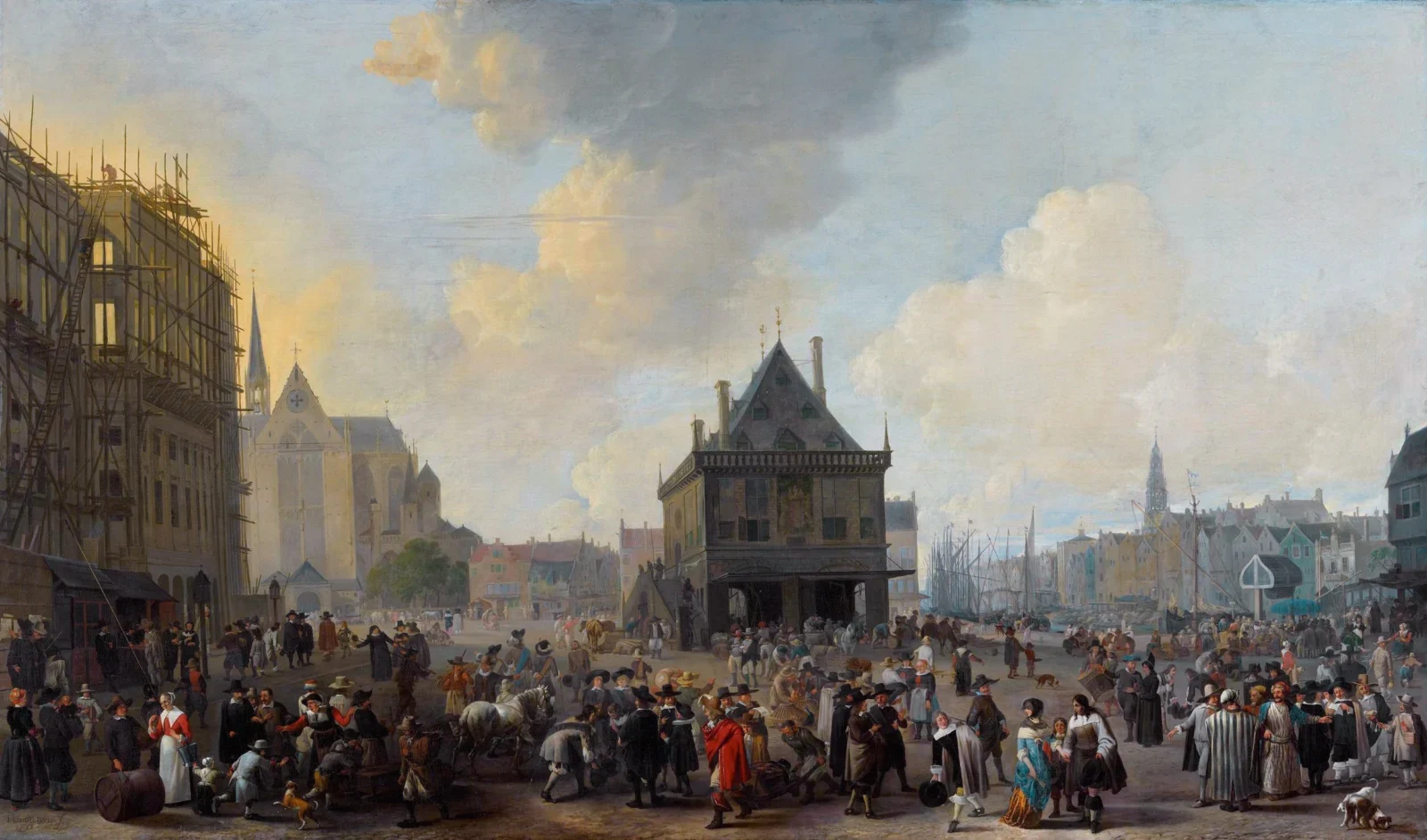
1588-1702 The Dutch golden age
We can roughly divide the golden age into 3 periods:
The Spanish and Portuguese period (1588-1648). The war of independence with Spain would last until the Peace of Munster in 1648 and was led first by Prince Maurits and later by Prince Frederik-Hendrik, both sons of Willem of Orange who was murdered in 1584. With the formation of the Republic, feudal society (nobles) changed into a central government with representatives of the people. In the Republic, power lay with the government, called the States General, consisting of representatives from all seven provinces. Holland and Zeeland were the most powerful provinces due to their size and wealth (mainly through trade) and both were delegated by one Council Pensionary. The provinces were governed by cities and cities, in turn by regents, almost all of whom were merchants. Actual power in the Republic therefore lay with the regents, most of whom were represented by the Council Pensionary. Until 1588 the Stadtholder, always a member of the nobility, had not acquired any new political power in the Republic due to the deposition of Philip as monarch. He was also not a member of the States General. In fact, he only led the army and the fleet, but the Stadtholder had many supporters among the population and regents. In other words, he did have political power indirectly. From the start of the revolution, the Stadtholder of the Republic had always been someone from the House of Orange. The House of Orange was still intermarried with international kingdoms, mainly in Germany, England and France. The kingdoms of Europe did everything they could to return power in the Republic to the Stadtholder and to elevate him to King so that the power of the regents and population would be broken. They were always terrified that the example of the Republic would also cause revolts in their kingdoms. The history of the Republic is a history of a constant struggle for power and influence between the Counsil Pensionary (regents) and Stadtholders (orangists). The first struggle took place in the 12 years truce, where Stadtholder Maurits won over Johan van Oldebarnevelt. While heavy fighting between Spain and the Republic mainly took place in the Republic and the Spanish Netherlands, the Dutch had established two companies that conquered important Portuguese and Spanish territories in Brazil, Africa, India, Ceylon, Formosa and the East Indies. As a result, they were no longer dependent on the Portuguese for trade and the Spanish trade embargo no longer mattered. In fact, the Republic in turn excluded other powers from trade and blocked the port of Antwerp and thus the supply to the Spanish Netherlands. This created a complete monopoly on the trade in the products mentioned. The companies were called the Vereenigde Oostindische Compagnie (VOC) and the West Indische Compagnie (WIC). The Republic had become one of the most prosperous countries in the world at the Peace of Munster in 1648. In these years, 80% of world trade took place with a Dutch ship.
The English period (1650-1674). The Republic fought three wars with their former ally England. The first in 1652, four years after independence and the last one ended in 1674. All were mainly fought at sea with magical naval battles and all had the same goal; power over world trade and through this power over the world. The same period was accompanied by new fierce internal power struggles between orangists and regents. Although the title Stadholder was not hereditary, as was customary with a king, it was customary in the Republic for someone from the House of Orange to become Stadholder; usually the son. When the stadtholder William II suddenly died in 1650, his son, William III, had not yet been born. The Republic decided not to appoint a new stadtholder, making the the Council Pensionary the most powerful person. This period is known as the first Stadtholderless period. As of 1653 Counsil Pensionary Johan de Witt led The Republic through the most successful period of the golden age until his death in 1672. In that year (disaster year) the Republic was simultaneously attacked by England, France and the two German dioceses of Munster and Cologne. Out of dissatisfaction, fear and anger, Johan de Witt and his brother were lynched in The Hague and Willem III was appointed Stadtholder and power return to the orangists. In 1689 William III also became king of England and Scotland (Glorious Revolution) and the personal union between the Republic and the Kingdom of England was created. The enemies were allies again.
The French period (1672-1702). The war with the France of Louis XIV (the Sun King) would last from the invasion of 1672 to 1679 (Dutch War), after which France tried to destroy the Netherlands economically, which almost succeeded. In 1688 France started a new war (Nine Years’ War until 1697) for territorial expansion in which it was defeated by an alliance of countries, including the Netherlands and England. The costs of these wars had now greatly weakened the Republic and domination of the sea had to be left to England. The Republic had definitively lost its world power to England and France. In 1702 William III had died childless and we had the second Stadtholderless period. This year is generally regarded as the end of the Dutch golden age. Cynically, in 1795 The Republic will eventually cease to exist and via the Batavian Republic, merge willingly into the French Empire of Emperor Napoleon Bonaparte.
Most significant periods of the Republic
The Republic in the world
In the 17th century, the Dutch were involved in several parts of the world. Here’s a breakdown of their involvement in different regions:
- The Dutch Republic, consisting of the North and South Netherlands, was the centre of Dutch power and influence.
- Europe: The Dutch had huge involvement in Europe, particularly through their economic prowess and trade networks and had many conflicts with other European powers, such as Portugal, Spain, England and France.
- Africa: The Dutch had involvement in Africa, including the establishment of trade networks, forts, and colonies. They had a presence in regions such as the Gold Coast (Ghana), Guinea, Angola, and Mozambique.
- North America: The Dutch established the colonies New Holland and New Netherland in North America, which included areas such as present-day New York, New Jersey, Delaware, and Connecticut.
- South America and Caribbean: The Dutch had a significant presence in South America and the Caribbean. They occupied parts of the Guianas (Suriname) and northeastern Brasil during the Dutch Brasil era and established colonies and trading posts in the Caribbean islands, including Curaçao, Aruba, Bonaire, Saba, and Sint Eustatius.
- Middle East and Asia: They were heavily involved in the Middle East through trading posts and in Asia, primarily through their activities in the East Indies (modern-day Indonesia) and Ceylon, India and Formosa and trade with Japan and China.

